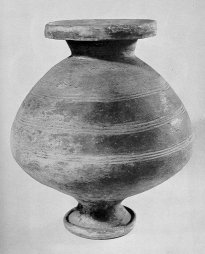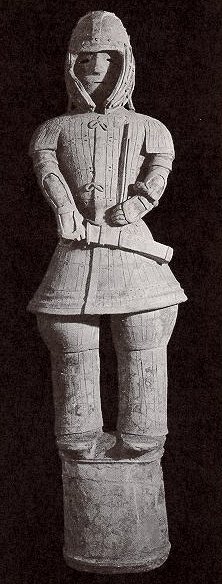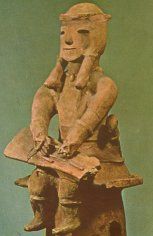
Yayoi Period 300 BCE-300 CE
Pottery made during this time was done by using a turning wheel. The designs, though, were simpler than those of the Jomon period. The society was changing from a nomadic one to a settled agrarian society which is reflected in the clothing worn by people during this time. The changes in the pottery spread from the south to the north, probably as the people from the Jomon period were driven north.
The clothing was probably relatively loose-fitting to allow people to bend in the rice fields, rice cultivation having been introduced from China. A Chinese work of the time, the Wei Chih, describes the people of Japan, noting that the men wore clothing that was wrapped around the body. Women wore large cloths with holes cut in the center for their heads. That might and might not be true, though, since it is also possible that the author of the work was presenting a distorted view of the Japanese. The geta, or wooden clogs, had its origins during this time.

A clay pot from the Yayoi period
The Yayoi period vessels are usually dark red. Their designs are simple, lacking the detailed artwork of the Jomon pottery.
There were three main centers of culture during this period were at Izumo on the Janap Sea side of Honshu; one was at Ise in the Yamato area, and the third was on the southern island of Kyushu. The Yamato-area culture gradually became the dominant of the three.
There are various grave mounds constructed from the third to the sixth centuries that have been examined. These were relatively simple, but very large mounds used for graves of rulers. The mound for Emperor Nintoku is about 1620 feet long and ninety feet high and is also surrounded by a moat.
The tombs had various burial objects in them such as jewels, weapons, mirrors, and vases, much as Egyptian tombs had similar objects. One of the most significant of the objects connected to the mounds are the haniwa which were cylinders filled with dirt and placed around the base of the mound. These were sometimes ornamented with various figures such as those of humans, animals, houses and utensils. From these were are able to get an idea of what the people of that time wore.
The indications are that there were various petty kings or chieftains during this time. Shamanism seems to be a major religious belief of the time, with an emphasis on fertility and fear of the dead.

Haniwa of an armored man
The tomb of emperor Nintoku, for example, had 11,280 of these figurines.
When you add the information given to us by the figures of utensils, animals and other things we are able to construct a fairly good idea of what Yayoi culture was like. One of the things we are shown is that there was a strong Chinese influence on the culture. Bronze mirrors found in the tombs, for example, sometimes were similar to those found in China and sometimes actually came from China.

A haniwa showing a woman playing a musical instrument.
There were also curved jewels called magatama. Along with swords, the mirrors and jewels form the three sacred treasures of Shintoism.
There were also bronze bells called dotaku found, but their purpose isn't known. They might date back to the first century before the Common Era but even that is not exactly determined.
There are also surviving paintings from the Yayoi period, but they are primitive and few in number.
Specific dates of importance
290-215 B.C.E.: Emperor Korei
214-158 B.C.E.: Emperor Kogen
158-98 B.C.E.: Emperor Kaika
97-30 B.C.E.: Emperor Sujin
29 B.C. E. - 70 C.E.: Emperor Suinin
37 CE: Arrival of the first Japanese envoy to the Chinese Han court.
71-130 C.E.: Emperor Keiko. He had 80 children.
131-190 C.E.: Emperor Seimu. Appointed clan chieftans to assist in the administration of the country, and incidentally to help extend his authority beyond the capital.
192-200 C.E.: Emperor Chuai (Chilai?). Killed in action against the Kumaso tribes.
201-269 C.E.: Regent Jingu Kogo
270-310 C.E.: Emperor Ojin. Fostered trade with China and Korea, adn established the marine department.
|